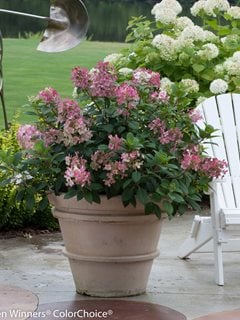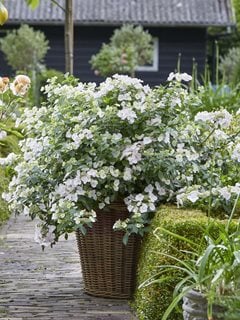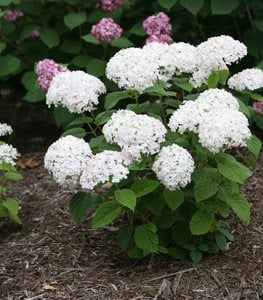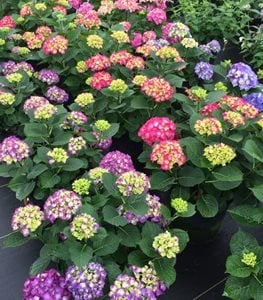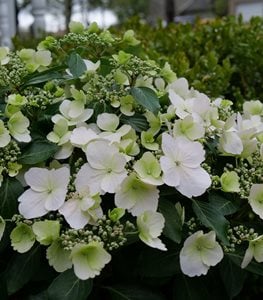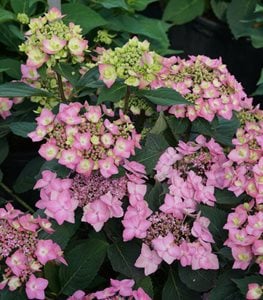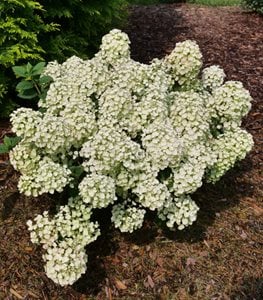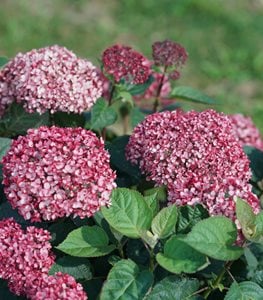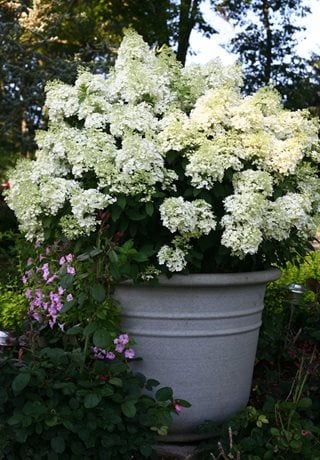Can Hydrangeas Grow in Pots?
Get tips for planting and caring for potted hydrangeas and take a look at some of our favorite container-friendly varieties.
Bobo® panicle hydrangea. Photo by: Proven Winners
9 Steps for Beautiful Potted Hydrangeas:- Pick the right pot.
- Choose the right variety.
- Plant correctly.
- Provide the right amount of sun.
- Water often.
- Fertilize sparingly.
- Prune as needed.
- Know when to transplant.
- Overwinter outdoors.
With their huge, billowy flower heads and long-lasting blooms, hydrangeas have become one of the most popular shrubs in the garden for vibrant summer color. But you can also enjoy their floral beauty on a porch, patio, or balcony by simply popping them into containers, alone or along with other plantings. Growing hydrangeas in pots rather than in a garden bed is also a great option if you have limited space or lack the right soil or exposure conditions for hydrangea shrubs.
Thanks to the development of newer cultivars, you don’t have to look far to find compact varieties of hydrangeas that fit comfortably into pots and planters, including a number of dwarf selections that grow no taller than 2 or 3 feet. Although growing hydrangeas in containers is really no more difficult than growing hydrangeas in the garden, you do need to follow a few key rules to keep them healthy and in bloom.
1. PICK THE RIGHT POT
The size and type of container you choose will often depend on whether you intend to treat your hydrangea as an annual and keep it in the pot for just one growing season or as a perennial, in which case it will stay outdoors in the container season after season.
For temporary plantings, what the container is made of is not important as long as it holds soil and has drainage holes in the bottom to allow excess water to drain out of the pot. For more permanent plantings, it’s best to buy an all-weather pot that won’t crack in freezing temperatures, especially if you live in a cold climate. That means avoiding untreated porous containers made of clay, terracotta, or ceramic.
The size of the container is particularly important, since the plant's roots will need room to grow during its stay. Generally, a large pot measuring at least 24 inches in diameter is roomy enough to accommodate a small to midsized hydrangea for several years. A pot that size will be heavy, so consider investing in a rolling plant caddy to allow for greater mobility.
"Choosing the right planter is key. For hydrangeas, I recommend at least a 32" tall and wide planter with good drainage. A soil mix of 50% potting soil, 30% fish soil, and 20% compost will provide long-term nutrients, though annual fertilizing is still essential to keep plants healthy." — Samantha, Margaret Valley Landscaping.
2. CHOOSE THE RIGHT VARIETY
If you plan to grow your potted hydrangea as a perennial and overwinter it outdoors, the first thing to consider is whether the plant is cold hardy in your part of the country. You will have greater success keeping a potted hydrangea alive through winter if you choose a variety that is two zones hardier than yours. For example, if you live in zone 5, a hydrangea hardy down to zone 3 will have the best chance for survival.
You should also look for a hydrangea shrub that’s the right size for the space you plan to display it in. Although you can plant almost any hydrangea in a container, a compact or midsize variety won’t require a lot of pruning to maintain its shape or need to be repotted as frequently. For a permanent planting, the mature size of the hydrangea should be your guide. If you are using your hydrangea like an annual, choose a plant that’s already close to the size that suits your needs, since it is unlikely to outgrow its pot in one season.
Learn more about the various types of hydrangeas.
"I’ve always loved hydrangeas, but didn’t think I could grow them without a yard. Turns out they thrive in containers—just look for compact varieties like my favorite, Tiny Quick Fire!" — Bethany, ChicagoGardener.
3. PLANT CORRECTLY
The first rule of planting hydrangeas in containers is to always use a good-quality potting soil rather than ordinary garden soil, which is prone to compaction and can lead to poor drainage (see Potting Soil 101). Using potting soil will also keep the container lighter, making it easier to move if you need to.
To help prevent the soil from escaping through the drainage holes in the pot, line the bottom of the container first with a piece of fine mesh or a coffee filter before filling. Next, add enough potting soil to the bottom of the container so that when you place the hydrangea in the pot, the top of the rootball sits at least 2 inches below the rim of the container.
Remove your hydrangea from the nursery pot and place it in the center of the container, filling soil in around it and up to (but not over) the top edge of the rootball. Water thoroughly and then check the soil level again. If the soil settles in areas and exposes the rootball, fill in the low spots. You may also want to place a layer of organic mulch on the soil surface to help preserve moisture and keep the roots of your shrub cool during the heat of summer.
4. PROVIDE THE RIGHT AMOUNT OF SUN
For optimal flowering, place your potted hydrangeas in a location that receives at least 4 to 6 hours of sunlight daily. The amount of sun they can handle depends on the type of hydrangea you’re growing. Panicle hydrangeas are the most sun tolerant variety and will do well in 6 or more hours of direct sunlight, while some other hydrangeas prefer more shaded areas. In warmer southern climates, all hydrangeas will benefit from afternoon shade to reduce water loss and heat stress.
One of the great things about growing hydrangeas in containers is that you can place your pots in a spot that provides the amount of sun exposure your plant requires. If your pots are resting on plant caddies, you can also move them around as needed to shelter them from direct afternoon sun.
5. WATER OFTEN
Soil in containers dries out much more quickly than soil in the garden, so you should check the moisture levels of your potted hydrangeas daily to make sure they are well hydrated. When the top inch or so of potting mix feels dry to the touch, soak your plants thoroughly until the water drains from the bottom of the pot. Drooping foliage is another sign that your hydrangeas need a drink. During hot, dry spells, you may need to water your plants every day or even twice a day to avoid subjecting them to heat stress.
Tip: If you tend to be forgetful about watering, consider growing your hydrangeas in self-watering containers to extend the time between waterings.
6. FERTILIZE SPARINGLY
Container-grown hydrangeas don’t need frequent fertilization, but the timing of fertilizer application is important.
If your plant is newly potted and the soil already contains a slow-release fertilizer, there’s no need to provide additional applications of fertilizer during the growing season. For hydrangeas that you intend to keep as permanent plantings, you will need to reapply an all-purpose flowering shrub or rose fertilizer each year in early spring. If you are growing a reblooming hydrangea, another dose of fertilizer in late spring can be beneficial to keep your plants blooming vigorously all summer. Be sure not to fertilize your plants in late summer or fall, since this can stimulate new growth late in the season and leave your plants vulnerable to frost damage.
Learn more about fertilizing hydrangea shrubs.
7. PRUNE AS NEEDED
To keep your potted hydrangeas from getting too tall and bushy for their confined quarters, you may need to prune them on occasion to maintain the desired shape. But first, identify the type of hydrangea you’re growing. Some plants bloom on old wood and should be pruned in late summer after they finish blooming, while others bloom on new growth and should be pruned in late winter or early spring. Repeat blooming hydrangea varieties, which produce flowers on both old and new wood, should only be pruned to remove faded flowers and dead and diseased branches.
Learn more about how and when to prune hydrangeas.
8. KNOW WHEN TO TRANSPLANT
While hydrangeas can grow successfully in a large container for several years, at some point they will need to be transplanted into a larger container or into the garden if you want to keep them healthy. You’ll know your hydrangea needs to be transplanted when its growth starts to slow down or stall and flower production is diminished. The roots in the container will also take up more space, reducing the water holding capacity of the soil.
If transplanting your hydrangea into another pot, choose a container a couple of sizes bigger than the existing one and fill it with fresh potting soil. Although you can transplant your hydrangea at any time of year, the best time is during late fall or early spring, while the plants are dormant. Avoid transplanting your hydrangeas during the heat of the summer, especially in warmer climates.
9. OVERWINTER OUTDOORS
Potted hydrangeas shouldn’t be moved indoors during winter if you want them to bloom the following season because they need to go through a natural dormancy period. If your hydrangeas are winter hardy in your climate, they can often overwinter in place. However, they will usually require some protection from harsh winds and bitter cold to prevent damage to the roots.
One solution is to move the pots to a spot sheltered from the wind but still exposed to sunlight and rain. Other options include sinking the pots in the ground to protect the roots from the cold or wrapping them in insulating blankets made of materials such as fleece, burlap or bubble wrap.
Keeping your potted hydrangeas hydrated in winter is also important. If the soil begins to dry out, give your plants enough water to keep the soil evenly moist but not waterlogged. The best time to water is during the day and when temperatures are above freezing. If the forecast predicts windy or freezing conditions, try to water your plants beforehand.
Get more advice on protecting and caring for hydrangeas during winter.
6 GREAT HYDRANGEAS FOR CONTAINERS
INVINCIBELLE WEE WHITE®
Hydrangea arborescens
This dwarf version of the popular ‘Annabelle’ hydrangea is the perfect size for containers and exceptionally hardy, so it overwinters well in even the harshest climates. The long-lasting mophead flowers are a soft blush pink when they emerge, gradually changing to pure white as the summer progresses.
Bloom time: Summer to fallHeight/spread: 1 to 3 feet tall and wide
Zones: 3-8
WEE BIT GIDDY®
Hydrangea macrophylla
The bold, magenta red flowers of this compact bigleaf hydrangea rebloom throughout the summer to provide a long season of brilliant color. When planted in acidic soil, the blooms will transform into a deep, rich violet-red. Because this plant blooms off of old and new growth, don’t prune unless necessary so you won’t sacrifice any developing flowers.
Bloom time: Early to late summerHeight/spread: 24 inches tall, 30 inches wide
Zones: 5-9
FAIRYTRAIL BRIDE®
Hydrangea x
A winner of the prestigious Plant of the Year Award from the Chelsea Flower Show in 2018, this new cascading form of hydrangea looks lovely spilling over the sides of a container or even a hanging basket. The frilly, white lacecap blooms run along the entire length of each trailing stem, creating a stunning floral display.
Bloom time: Spring to summerHeight/spread: 4 feet tall and wide
Zones: 6-9
LET'S DANCE CAN DO!®
Hydrangea macrophylla x serrata
This midsize bigleaf hydrangea features large lacecap flowerheads that line the stems from top to bottom, instead of only at the tips like other bigleaf varieties. A fast rebloomer, it also provides a nearly continuous display of bubblegum pink flowers (or lavender blue in acidic soils), keeping your container plantings fresh and vibrant throughout the season.
Bloom time: Summer, reblooming through autumnHeight/spread: 3 to 4 feet tall, 3 feet wide
Zones: 6-9
TINY QUICK FIRE®
Hydrangea paniculata
A gorgeous addition to containers as well as gardens with limited space, this prolific bloomer is among the smallest of the panicle hydrangeas. The large billowy blooms, which nearly obscure the tidy mounds of green foliage, start out pure white and develop bright reddish-pink tones as they age, retaining their color for the rest of the season.
Bloom time: Early to late summerHeight/spread: 1-1/2 to 3 feet tall, 2 to 3 feet wide
Zones: 3-8
INVINCIBELLE GARNETTA®
Hydrangea arborescens
Full and plush garnet-colored domed flower heads, held upright on sturdy stems, bloom for months on this repeat-flowering hydrangea, starting in midsummer. Blooms reliably year after year, even in colder climates. For the strongest stems and most abundant flowering, locate this plant in a spot that receives at least of six hours of sunlight daily.
Bloom time: Summer into fallHeight/spread: 30 inches tall and wide
Zones: 3-8
See more dwarf hydrangeas
RELATED:
Container Plants for Full Sun
Container Plants for Shade
Container Garden Ideas
Success Secrets for Healthy Container Gardens
Growing Lantana in Pots
